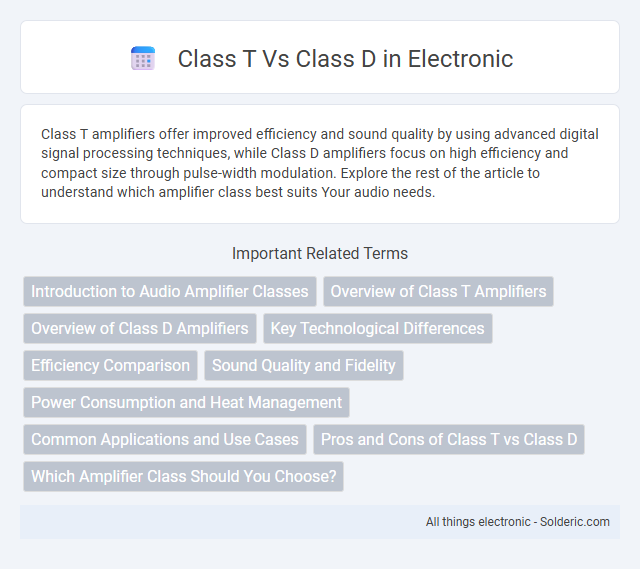Class T amplifiers offer improved efficiency and sound quality by using advanced digital signal processing techniques, while Class D amplifiers focus on high efficiency and compact size through pulse-width modulation. Explore the rest of the article to understand which amplifier class best suits Your audio needs.
Comparison Table
| Feature | Class T Amplifier | Class D Amplifier |
|---|---|---|
| Technology | Tripath's proprietary digital modulation | PWM-based switching amplifier |
| Efficiency | Up to 85-90% | Typically 85-95% |
| Sound Quality | High fidelity, warm and smooth audio | Good fidelity, some switching noise possible |
| Distortion | Low Total Harmonic Distortion (THD) & Noise | Moderate THD, depends on design |
| Heat Generation | Lower heat due to efficient switching | Low heat output |
| Size | Compact, integrated chip design | Very compact, minimal heat sink needed |
| Applications | Home audio, portable devices, high-end audio | Car audio, portable speakers, PA systems |
| Cost | Higher due to proprietary technology | Generally lower, mass-produced |
| Availability | Limited, mostly Tripath-based products | Widely available from multiple manufacturers |
Introduction to Audio Amplifier Classes
Class T audio amplifiers utilize digital signal processing combined with analog components to deliver high-efficiency sound amplification, often resulting in improved audio precision and lower distortion. Class D amplifiers operate using pulse-width modulation to switch output transistors on and off rapidly, achieving efficient power conversion with minimal heat dissipation. Both classes are preferred in portable and compact audio devices due to their superior energy efficiency compared to traditional linear amplifiers.
Overview of Class T Amplifiers
Class T amplifiers are a specialized subset of Class D amplifiers featuring advanced digital signal processing and modulation techniques to improve audio fidelity and reduce distortion. They combine the efficiency of Class D amplifiers with enhanced sound quality through proprietary algorithms that optimize switching behavior. These amplifiers deliver high power output with lower heat dissipation, making them ideal for compact, high-performance audio applications.
Overview of Class D Amplifiers
Class D amplifiers use pulse-width modulation (PWM) to efficiently amplify audio signals with high power efficiency, often exceeding 90%, making them ideal for portable and high-power applications. Their switching operation generates less heat compared to Class T amplifiers, which employ proprietary algorithms based on Class D principles but with enhanced signal processing for improved audio clarity. Class D amplifiers dominate in modern audio devices due to their compact size, reduced power consumption, and ability to deliver strong output power with minimal distortion.
Key Technological Differences
Class T amplifiers utilize a unique digital signal processing algorithm combined with high-frequency switching to achieve efficient power conversion, offering improved sound quality over traditional Class D designs. Class D amplifiers operate by rapidly switching output transistors between on and off states, delivering high efficiency but sometimes at the expense of increased distortion and electromagnetic interference. The fundamental technological difference lies in Class T's proprietary modulation technique, which enhances linearity and reduces noise compared to the simpler pulse-width modulation found in most Class D amplifiers.
Efficiency Comparison
Class D amplifiers achieve efficiency levels typically between 85% and 95%, significantly reducing power loss and heat generation compared to Class T amplifiers, which exhibit efficiency around 70% to 80%. Your audio setup benefits from Class D's superior energy savings, especially in portable or battery-powered devices. The higher efficiency of Class D ensures longer device lifespan and lower energy costs without compromising sound quality.
Sound Quality and Fidelity
Class T amplifiers offer high sound quality and fidelity due to their hybrid design, combining analog processing with digital control to reduce distortion and noise. Class D amplifiers, known for efficiency, have improved significantly with advanced modulation techniques, delivering clean and powerful audio with minimal harmonic distortion. While both classes provide excellent audio performance, Class T typically excels in nuanced sound reproduction, whereas Class D is favored for high power output and compact design without compromising clarity.
Power Consumption and Heat Management
Class T amplifiers offer improved power efficiency over traditional Class AB designs, consuming less power during operation, which results in moderate heat generation. Class D amplifiers excel in power efficiency, often exceeding 90%, significantly reducing energy consumption and producing minimal heat, making them ideal for compact or portable audio systems. Effective heat management in Class T involves passive cooling methods, while Class D typically requires minimal cooling due to its high efficiency and low thermal output.
Common Applications and Use Cases
Class T amplifiers excel in portable audio devices and home theater systems due to their high efficiency and compact size, making them ideal for battery-powered applications. Class D amplifiers are widely used in car audio systems, subwoofers, and large-scale public address systems because of their superior power handling and minimal heat dissipation. Your choice between Class T and Class D depends on the specific power requirements and thermal constraints of your audio setup.
Pros and Cons of Class T vs Class D
Class T amplifiers offer high efficiency and compact size with low distortion, making them ideal for audiophiles seeking high-fidelity audio in small devices. Class D amplifiers excel in power efficiency and heat dissipation, suitable for applications requiring high output power and long battery life, though they may introduce more electrical noise. Your choice between Class T and Class D depends on whether audio quality or power efficiency is your top priority.
Which Amplifier Class Should You Choose?
Class T amplifiers deliver high efficiency with excellent sound quality using proprietary digital processing, ideal for compact, high-fidelity audio systems. Class D amplifiers offer superior power efficiency and reduced heat generation, making them perfect for large, portable, or battery-powered devices requiring robust output. Choosing between Class T and Class D depends on your priority for sound precision versus power efficiency and application size.
Class T vs Class D Infographic

 solderic.com
solderic.com